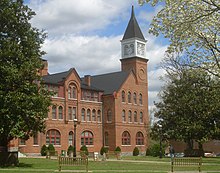Tahlequah, Oklahoma: Difference between revisions
m Reverted edits by 164.58.180.210 (talk) to last version by Uyvsdi |
No edit summary |
||
| Line 117: | Line 117: | ||
* [[Chad_%22Corntassel%22_Smith|Chad Smith]], Principal Chief of the Cherokee Nation, lawyer |
* [[Chad_%22Corntassel%22_Smith|Chad Smith]], Principal Chief of the Cherokee Nation, lawyer |
||
* [[Merle Travis]], country singer and musician, 1917–1983 |
* [[Merle Travis]], country singer and musician, 1917–1983 |
||
* [[Tory Lander]], famous prostitute and pornographic film star. |
|||
==References== |
==References== |
||
{{Reflist}} |
{{Reflist}} |
||
Revision as of 18:21, 30 November 2010
Tahlequah, Oklahoma | |
|---|---|
 Tahlequah, September 14, 2008 | |
 Location of Tahlequah, Oklahoma | |
| Country | United States |
| State | Oklahoma |
| County | Cherokee |
| Government | |
| • Mayor | Ken Purdy |
| Area | |
| • Total | 12.0 sq mi (31.1 km2) |
| • Land | 12.0 sq mi (31.1 km2) |
| • Water | 0.0 sq mi (0.0 km2) |
| Elevation | 797 ft (243 m) |
| Population (2000) | |
| • Total | 14,458 |
| • Density | 1,202.8/sq mi (464.4/km2) |
| Time zone | UTC-6 (Central (CST)) |
| • Summer (DST) | UTC-5 (CDT) |
| ZIP codes | 74464-74465 |
| Area code | 918 |
| FIPS code | 40-72100Template:GR |
| GNIS feature ID | 1098721Template:GR |
Tahlequah (Cherokee: ᏓᎵᏆ,[1] pronounced /ˈtælɨkwɑː/ TAL-ə-kwah) is a city in Cherokee County, Oklahoma, United States located at the foothills of the Ozark Mountains. The population was 14,458 at the 2000 census. It is the county seat of Cherokee CountyTemplate:GR. The main campus of Northeastern State University is located in the city. It is also the capital of the United Keetoowah Band of Cherokee Indians and the Cherokee Nation. Tahlequah is also known for being featured in the book, Where the Red Fern Grows by Wilson Rawls.
Origin of the name
The name, according to legend, derives from the Cherokee word "Ta'ligwu" meaning "just two," or "two is enough." The "two" refers to a meeting between elders that presumably took place shortly after the Trail of Tears. Three tribal elders had planned to meet to determine the location of the Cherokee Nation's permanent capital. Two elders arrived and waited for the third. As dusk approached, they decided that "two is enough."
A more likely origin for the name is that it is named for an ancient eastern Cherokee town of Great Tellico, the English spelling of Cherokee Talikwa, the meaning of which is lost, according to James Mooney, although some trace it to the word tel-i-quah which is interpreted as "plains".
Indian Capital
Tahlequah has the distinction of being the capital of both the Cherokee Nation and the United Keetoowah Band of Cherokee Indians.
There are several markers of Cherokee and Native American heritage found across town: street signs and business signs appear in the Cherokee language along with English, mostly in the syllabary alphabet created by Sequoyah, a Cherokee scholar of the 1820s.
The Cherokee Supreme Court Building, located in downtown Tahlequah and constructed in 1844, is the oldest public building in Oklahoma.[2]
Geography
Tahlequah is located at 35°54′46″N 94°58′17″W / 35.91278°N 94.97139°WInvalid arguments have been passed to the {{#coordinates:}} function (35.912869, -94.971526)Template:GR.
According to the United States Census Bureau, the city has a total area of 12.0 square miles (31.1 km²), all land.
Demographics

As of the censusTemplate:GR of 2000, there were 14,458 people, 5,703 households, and 3,125 families residing in the city. The population density was 1,202.8/sq mi (464.4/km²). There were 6,245 housing units at an average density of 519.5/sq mi (200.6/km²). The racial makeup of the city was 59.01% White, 2.53% African American, 26.86% Native American, 0.53% Asian, 0.03% Pacific Islander, 4.10% from other races, and 6.93% from two or more races. Hispanic or Latino of any race were 7.26% of the population.
There were 5,703 households out of which 26.8% had children under the age of 18 living with them, 37.6% were married couples living together, 13.3% had a female householder with no husband present, and 45.2% were non-families. 34.2% of all households were made up of individuals and 11.6% had someone living alone who was 65 years of age or older. The average household size was 2.28 and the average family size was 3.00.
In the city the population was spread out with 22.2% under the age of 18, 25.2% from 18 to 24, 23.4% from 25 to 44, 16.1% from 45 to 64, and 13.0% who were 65 years of age or older. The median age was 26 years. For every 100 females there were 88.6 males. For every 100 females age 18 and over, there were 82.5 males.
The median income for a household in the city was $23,238, and the median income for a family was $34,811. Males had a median income of $25,066 versus $21,327 for females. The per capita income for the city was $13,371. About 18.5% of families and 26.3% of the population were below the poverty line, including 28.2% of those under age 18 and 12.6% of those age 65 or over.
Notable residents
- Roy Boney, Jr., animator, artist, graphic novelist, language advocate
- Robert J. Conley, author
- David Cornsilk, activist
- Stacy Leeds, tribal judge and Indian law professor
- Sonny Sixkiller, football player
- Chad Smith, Principal Chief of the Cherokee Nation, lawyer
- Merle Travis, country singer and musician, 1917–1983
- Tory Lander, famous prostitute and pornographic film star.
References
- Mooney, James. Myths of the Cherokee (1900, repr. 1995)
External links
- Tahlequah Events
- Tahlequah, OK Webpage
- The Cherokee Nation
- Northeastern State University
- Northeastern State University Alumni Community
- INTV Tahlequah Channel 25
- Tahlequah Tourism
- Tahlequah information, photos and videos on TravelOK.com Official travel and tourism website for the State of Oklahoma

